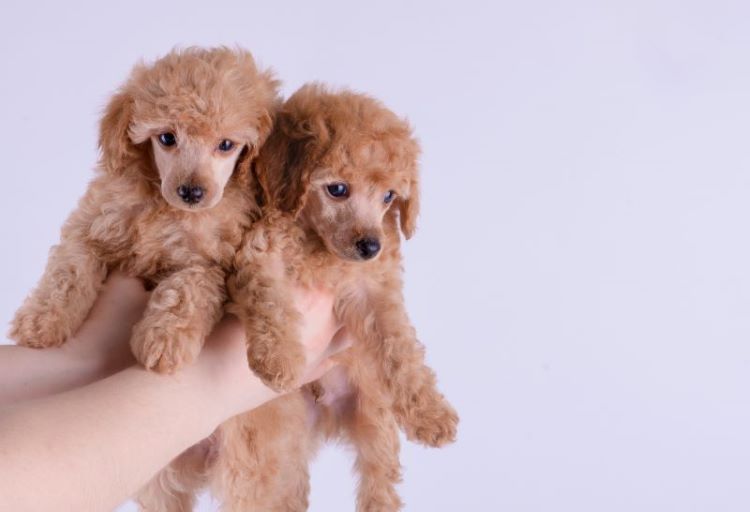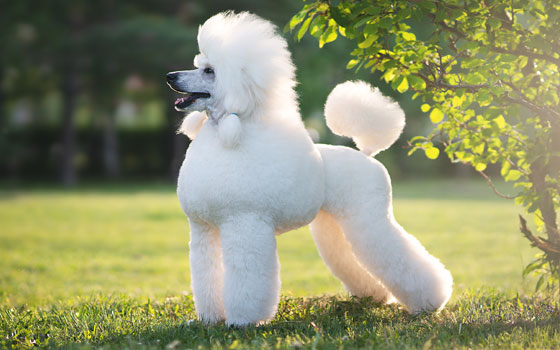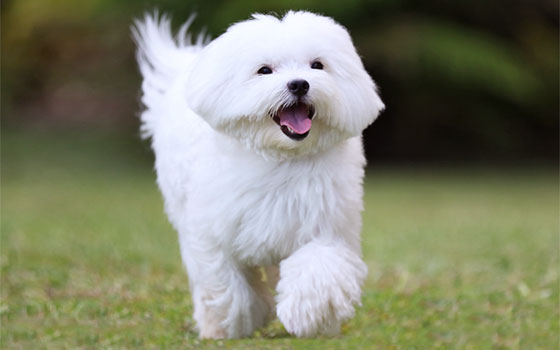Ready to help treat your pet to a healthy life?
Hypoallergenic & Non-Shedding Dog Breeds
By : Trupanion Staff | Updated May 1, 2025

When people refer to hypoallergenic pets they’re describing an animal that is less likely to provoke an allergic reaction. If you sneeze whenever you think about dogs, we have some bad news — a truly hypoallergenic dog breed does not exist. Dogs, like humans, shed skin cells known as dander that, along with fur and saliva, causes allergies in people. You may meet one or two hairless dogs, but you’ll never meet a dog without skin or saliva. So, unfortunately, you’ll never meet a truly hypoallergenic dog.
Some dog breeds, however, are less troublesome for people with allergies. Some have hair that grows to a certain length and then stops, and some have hair that grows continuously. Since the hair strands can be the source of allergies, the fewer hairs a dog sheds, the less fur accumulates around the house to trigger sneezes and sniffles.
Dogs with continually growing hair may receive frequent grooming — if they are bathed and brushed regularly, the presence of pet dander around the house will be reduced and allergen exposure decreased.
Symptoms of dog allergies
If you're reading this in search of a hypoallergenic dog breed, there's a good chance you're already aware that you or someone else in your household suffers from allergies to dogs. But just in case you're not sure, it's a good idea to be aware of the symptoms caused by sensitivity to dog allergens:
- Skin rashes / general redness
- Wheezing and shortness of breath
- Coughing
- Nasal irritation, including redness, swelling, discharge, and itching
- In severe cases, the face and/or neck may start swelling
If you are severely allergic to dogs to the point of needing to carry an Epipen or requiring emergency medical attention, it's probably not a good idea to bring a dog into your home. Since no dog breed is truly hypoallergenic, there is no guarantee that your allergies will never be triggered.

7 hypoallergenic dog breeds
Again, there is no such thing as a truly hypoallergenic dog. That said, there are certain types of dogs that are less likely to trigger allergies in people who are prone to them. Here is a list of some of our favorite "hypoallergenic" breeds to help you choose your perfect pooch. Keep in mind that there are other dog breeds that are low-shedding and may be considered allergy-friendly. So, this lineup is simply meant to serve as a general guide and help you get started on your search for a hypoallergenic dog friend.
1. Poodle
Known for their impressive looks, Poodles also happen to make loyal and athletic pets while going easy on human allergies to dogs. And of course, they're also renowned for their hypoallergenic qualities. Poodles have dense, curly coats that shed only minimally, and this helps to prevent excess dander from being released. Groom these dogs regularly (consider a professional for proper maintenance) to keep the famous Poodle coat from being as free of allergens as possible.
It's also worth mentioning that Poodle mixes — like the Goldendoodle and Labradoodle — are also considered hypoallergenic dog breeds. This is one reason why these newer breeds have risen considerably in popularity over the years.
2. Samoyed
With their big, floofy hair, it may come as a surprise that the Samoyed is another dog breed that is on the hypoallergenic side. That said, it depends how severe your allergies are as well as what exactly you're allergic to. These dogs shed their coats about twice a year, which could irritate more severe and sensitive cases of allergies to dogs. Samoyeds do nevertheless produce less dander than many other dog breeds, and they also are known to salivate a lot less. No dog drool? Yes, please.
3. Affenpinscher
Another hypoallergenic dog breed is the small, terrier-like Affenpinscher. This unique pup is dark and wiry-haired, but don't let its messy appearance fool you! The breed is generally low maintenance and doesn't tend to drool or slobber. The breed's low-shedding coat retains its low levels of dander well, meaning it won't constantly be blowing around your house and making you all sneezy.
4. Brussels Griffon
Compact and striking in appearance, the Brussels Griffon or "Griffon Bruxellois" happens to be extremely popular among those with allergies to dogs. And it's no wonder why! This dog has a thin, short coat consisting of wiry hair, and it only sheds during spring and fall. They also do not produce much dander.
5. Yorkshire Terrier
Yorkshire Terriers or "yorkies" are small, spunky dogs that make for highly affectionate family pets. They are also more hypoallergenic than most because they very rarely shed. Though they do not need much maintenance, regular grooming will help reduce the presence of allergens even further.
6. Maltese
With long, white hair, it's surprising that the Maltese is considered hypoallergenic. But this is because this friendly dog breed sheds little and produces relatively low levels of allergy-triggering dander. For even better management, try keeping the Maltese's coat trimmed on the short side.
7. Miniature Schnauzer
A small, distinguished-looking dog, the Miniature Schnauzer is another low-shed breed. Despite its longer, shaggy portions, the Schnauzer's coat is surprisingly low maintenance. Make sure you train them well though — Miniature Schnauzers can be feisty and even aggressive if not given the right boundaries or exercised properly.
Dog breeds to avoid if you have allergies
The right dog for you will depend both on the severity of your allergies as well as your temperament preferences. Though, again, there is no such thing as a truly hypoallergenic canine — every dog carries some level of allergens that those with sensitivities should be aware of. That said, there are certain dog breeds you may want to avoid right from the start due to their high levels of allergens. These include (but may not be limited to):
- Rottweiler
- Basset Hound
- Husky
- German Shepherd
Not sure how severe your allergies are or what particular canine allergens may trigger your senses the most? Talk with your doctor. They may be able to perform (or refer you to a specialist for) an allergy test that can provide more details.

Which hypoallergenic dog breed is best?
It stands to reason that large dogs will create more dander and shed more hair than a small dog, so if you have the choice, opt for a smaller version, such as a Toy Poodle instead of a Standard Poodle.
You can also help cut down on your pet allergy symptoms in the following ways:
- Restricting your dog to certain areas of the house
- Installing and regularly replacing air filters in your home
- Vacuuming frequently
- Bathing your dog regularly
Because these breeds have continuously growing hair, they will all need to visit a groomer every four to six weeks, so you should include this expense in your budget. But, with careful decision-making and care, you can enjoy one of these canine companions without a lot of allergy suffering. No matter which lovable dog you gravitate to, be smart and learn more about Trupanion’s dog insurance to keep them protected.
And, don't worry, cat lovers, we have you covered as well with this list of hypoallergenic cat breeds!
